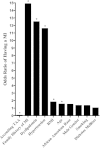Ascending thoracic aortic aneurysms protect against myocardial infarctions
- PMID: 25317029
- PMCID: PMC4169096
- DOI: 10.1055/s-0034-1382288
Ascending thoracic aortic aneurysms protect against myocardial infarctions
Abstract
There has been increasing evidence that ascending thoracic aortic aneurysms (TAAs) protect against atherosclerosis. However, there have been no studies examining the relationship between ascending TAAs and clinical endpoints of atherosclerosis, such as stroke or peripheral arterial disease. In this study, we aim to characterize the relationship between TAAs and a specific clinical endpoint of atherosclerosis, myocardial infarction (MI). We compared prevalence of coronary artery disease (CAD) and MIs in 487 patients who underwent surgical repair for ascending TAAs to 500 control patients who did not have an ascending TAA. Multivariate binary logistic regression was used to calculate the odds of having MI if a patient had an ascending TAA versus any of several MI risk factors. There was a significantly lower prevalence of CAD and MI in the ascending TAA group than in the control TAA group. The odds of having a MI if a patient had a MI risk factor were all > 1 (more likely to have a MI), with the lowest statistically significant odds ratio being 1.54 (age; p = 0.001) and the highest being 14.9 (family history of MI; p < 0.001). The odds ratio of having a MI if a patient had an ascending TAA, however, was near 0 at 0.05 (p < 0.001). This study provides evidence that ascending TAAs protect against MIs, adding further support to the hypothesis that ascending TAAs protect against atherosclerotic disease.
Keywords: acute coronary syndrome; aneurysm; atherosclerosis; cardiovascular risk factors; coronary artery; infarction; myocardial infarction.
Figures


Similar articles
-
Evidence Accumulates: Patients with Ascending Aneurysms Are Strongly Protected from Atherosclerotic Disease.Int J Mol Sci. 2023 Oct 27;24(21):15640. doi: 10.3390/ijms242115640. Int J Mol Sci. 2023. PMID: 37958625 Free PMC article. Review.
-
Prevalence of Thoracic Aortic Aneurysms in Patients with Degenerative Abdominal Aortic Aneurysms: Results from the Prospective ACTA Study.Eur J Vasc Endovasc Surg. 2021 Jun;61(6):930-937. doi: 10.1016/j.ejvs.2021.03.004. Epub 2021 Apr 20. Eur J Vasc Endovasc Surg. 2021. PMID: 33892987
-
Synchronous and Metachronous Thoracic Aortic Aneurysms in Patients With Abdominal Aortic Aneurysms: A Systematic Review and Meta-Analysis.J Am Heart Assoc. 2020 Nov 3;9(21):e017468. doi: 10.1161/JAHA.120.017468. Epub 2020 Oct 26. J Am Heart Assoc. 2020. PMID: 33103575 Free PMC article.
-
Pelvic artery aneurysm screening provides value in patients with thoracic aortic aneurysms.Int J Cardiovasc Imaging. 2017 Oct;33(10):1627-1635. doi: 10.1007/s10554-017-1178-z. Epub 2017 May 27. Int J Cardiovasc Imaging. 2017. PMID: 28551718
-
Differences in atherosclerotic profiles between patients with thoracic and abdominal aortic aneurysms.Am J Cardiol. 2008 Mar 1;101(5):696-9. doi: 10.1016/j.amjcard.2007.10.039. Epub 2007 Dec 21. Am J Cardiol. 2008. PMID: 18308024
Cited by
-
KIF6 Trp719Arg Genetic Variant Increases Risk for Thoracic Aortic Dissection.Genes (Basel). 2023 Jan 18;14(2):252. doi: 10.3390/genes14020252. Genes (Basel). 2023. PMID: 36833179 Free PMC article.
-
Extent of Coronary Artery Disease in Patients With Stenotic Bicuspid Versus Tricuspid Aortic Valves.J Am Heart Assoc. 2021 Jun 15;10(12):e020080. doi: 10.1161/JAHA.120.020080. Epub 2021 Jun 2. J Am Heart Assoc. 2021. PMID: 34075785 Free PMC article.
-
Evidence Accumulates: Patients with Ascending Aneurysms Are Strongly Protected from Atherosclerotic Disease.Int J Mol Sci. 2023 Oct 27;24(21):15640. doi: 10.3390/ijms242115640. Int J Mol Sci. 2023. PMID: 37958625 Free PMC article. Review.
-
Diabetes is not a negative prognostic factor for 30-days mortality after surgery for acute type A aortic dissection.Cardiovasc Endocrinol Metab. 2024 Jun 19;13(3):e0306. doi: 10.1097/XCE.0000000000000306. eCollection 2024 Sep. Cardiovasc Endocrinol Metab. 2024. PMID: 38903248 Free PMC article.
-
Stanford type B aortic dissection is more frequently associated with coronary artery atherosclerosis than type A.J Cardiothorac Surg. 2018 Jun 27;13(1):80. doi: 10.1186/s13019-018-0765-y. J Cardiothorac Surg. 2018. PMID: 29945663 Free PMC article.
References
-
- Kuzmik G A, Sang A X, Elefteriades J A. Natural history of thoracic aortic aneurysms. J Vasc Surg. 2012;56(2):565–571. - PubMed
-
- Cornuz J, Sidoti Pinto C, Tevaearai H, Egger M. Risk factors for asymptomatic abdominal aortic aneurysm: systematic review and meta-analysis of population-based screening studies. Eur J Public Health . 2004;14(4):343–349. - PubMed
-
- Johnsen S H, Forsdahl S H, Singh K, Jacobsen B K. Atherosclerosis in abdominal aortic aneurysms: a causal event or a process running in parallel? The Tromsø study. Arterioscler Thromb Vasc Biol . 2010;30(6):1263–1268. - PubMed
LinkOut - more resources
Full Text Sources
Other Literature Sources
Miscellaneous

